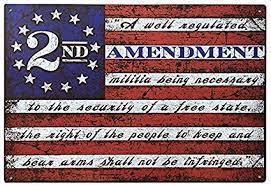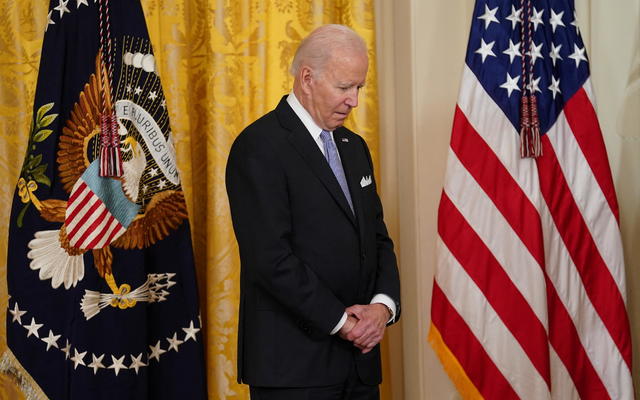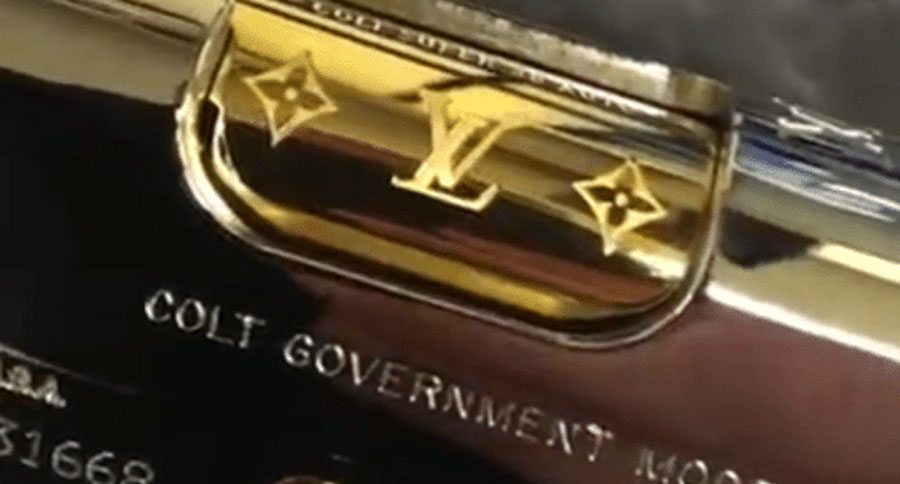Second Amendment – 2nd Amendment
 A well regulated Militia, being necessary to the security of a free State, the right of the people to keep and bear Arms, shall not be infringed.
A well regulated Militia, being necessary to the security of a free State, the right of the people to keep and bear Arms, shall not be infringed.
Second Amendment – Amendment II – Right to Bear Arms
The Second Amendment of the United States Constitution reads: “A well regulated Militia, being necessary to the security of a free State, the right of the people to keep and bear Arms, shall not be infringed.”
Such language has created considerable debate regarding the Amendment’s intended scope. On the one hand, some believe that the Amendment’s phrase “the right of the people to keep and bear Arms” creates an individual constitutional right to possess firearms. Under this “individual right theory,” the United States Constitution restricts legislative bodies from prohibiting firearm possession, or at the very least, the Amendment renders prohibitory and restrictive regulation presumptively unconstitutional. On the other hand, some scholars point to the prefatory language “a well regulated Militia” to argue that the Framers intended only to restrict Congress from legislating away a state’s right to self-defense. Scholars call this theory “the collective rights theory.” A collective rights theory of the Second Amendment asserts that citizens do not have an individual right to possess guns and that local, state, and federal legislative bodies therefore possess the authority to regulate firearms without implicating a constitutional right.
In 1939 the U.S. Supreme Court considered the matter in United States v. Miller, 307 U.S. 174. There, the Court adopted a collective rights approach, determining that Congress could regulate a sawed-off shotgun which moved in interstate commerce under the National Firearms Act of 1934 because the evidence did not suggest that the shotgun “has some reasonable relationship to the preservation or efficiency of a well regulated militia . . . .” The Court then explained that the Framers included the Second Amendment to ensure the effectiveness of the military.
This precedent stood for nearly 70 years until 2008, when the U.S. Supreme Court revisited the issue in the case of District of Columbia v. Heller, 478 F.3d 370. The plaintiff in Heller challenged the constitutionality of a Washington D.C. law which prohibited the possession of handguns. In a 5-4 decision, the Court struck down the D.C. handgun ban as violative of that right. The Court meticulously detailed the history and tradition of the Second Amendment at the time of the Constitutional Convention and proclaimed that the Second Amendment established an individual right for U.S. citizens to possess firearms. The Court carved out Miller as an exception to the general rule that Americans may possess firearms, claiming that law-abiding citizens cannot use sawed-off shotguns for any law-abiding purpose. Similarly, the Court in dicta stated that firearm regulations would not implicate the Second Amendment if that weaponry cannot be used for law-abiding purposes. Further, the Court suggested that the United States Constitution would not disallow regulations prohibiting criminals and the mentally ill from firearm possession.
In 2010, the Court further strengthened Second Amendment protections in McDonald v. City of Chicago, 567 F.3d 856. The plaintiff in McDonald challenged the constitutionality of the Chicago handgun ban, which prohibited handgun possession by almost all private citizens. In a 5-4 decision, the Court, citing the intentions of the framers and ratifiers of the Fourteenth Amendment, held that the Second Amendment applies to the states through the incorporation doctrine. The Court lacked a majority on which specific clause of the Fourteenth Amendment incorporates the fundamental right to keep and bear arms for the purpose of self-defense. While Justice Alito and his supporters looked to the Due Process Clause, Justice Thomas in his concurrence stated that the Privileges and Immunities Clause should justify incorporation.
Several questions still remain unanswered, however, such as whether regulations less stringent than the D.C. statute implicate the Second Amendment, whether lower courts will apply their dicta regarding permissible restrictions, and what level of scrutiny the courts should apply when analyzing a statute that infringes on the Second Amendment. Generally, in constitutional law, courts subject statutes and ordinances to three levels of scrutiny, depending on the issue at hand:
- strict scrutiny
- intermediate scrutiny
- rational basis
Circuit Court opinions following Heller suggests that courts are willing to uphold the following:
- Regulations prohibiting weapons on government property. US v Dorosan, 350 Fed. Appx. 874 (5th Cir. 2009) (upholding defendant’s conviction for bringing a handgun onto post office property).
- Regulations prohibiting possession of a handgun as a juvenile delinquent. US v Rene E., 583 F.3d 8 (1st Cir. 2009) (holding that the Juvenile Delinquency Act ban of juvenile possession of handguns did not violate the Second Amendment).
- Regulations requiring a permit to carry concealed weapon. Kachalsky v County of Westchester, 701 F.3d 81 (2nd Cir. 2012) (holding that a New York law preventing individuals from obtaining a license to possess a concealed firearm in public for general purposes unless the individual showed proper cause did not violate the Second Amendment).
More recently, the U.S. Supreme Court reinforced its Heller ruling in Caetano v. Massachusetts, 136 S.Ct. 1027 (2016). The Court struck down a Massachusetts statute which prohibited the possession or use of “stun guns” by finding that “stun guns” are protected under the Second Amendment. While ruling largely on the reasoning of Heller, the opinion was per curiam and therefore did not significantly add to Second Amendment jurisprudence.
In 2022, the Supreme Court further expanded upon the precedent set by Heller in New York State Rifle & Pistol Association v. Bruen. In Bruen, the Court struck down a New York law requiring parties interested in purchasing a handgun for the use of self-defense outside of the home to obtain a license because the law issued licenses on a “may-issue” rather than a “shall issue” basis. This “may issue” licensing method allowed state authorities to deny interested parties public use licenses for firearms if the interested party was unable to show “proper cause” as to why they have a heightened need for self-protection over the general population.
Furthermore, the Court disavowed the use of “means-end tests” many jurisdictions had adopted for the purposes of interpreting the Second Amendment, instead ruling that a Second Amendment analysis is limited to evaluating the historical nature of the right and whether a given use of a firearm or other weapon is deeply rooted in the history of the United States. Post-Bruen, courts can no longer use a standard scrutiny analysis like the one seen in Kachalsky v. County of Westchester to determine if a gun regulation is constitutional. Instead, a government wishing to place restrictions on firearm ownership must “affirmatively prove that its firearms regulation is part of the historical tradition that delimits the outer bounds of the right to keep and bear arms.”
In a concurrence, Justice Kavanaugh joined by Justice Roberts emphasizes that Bruen is not intended to invalidate “shall-issue” licensing structures or other restrictions on firearm ownership including fingerprinting, background checks, mental health evaluations, mandatory training requirements, and potential other requirements. Additionally, this concurrence draws a line between objective gun control measures, where an individual must pass a set of predetermined requirements, which are constitutional, and subjective gun control measures, such as licensing at a state official’s discretion, which are not.
It remains to be seen how the ruling in Bruen and the sentiments espoused in this concurrence will influence cases going forward.
See also: Constitutional Amendment.
cited https://www.law.cornell.edu/wex/second_amendment

New York State Rifle and Pistol Association v. Bruen
Shortly after the U.S. Supreme Court ruling last month that expanded the right to carry firearms outside the home, gun rights activist Andrew Namiki Roberts rushed to the Honolulu Police Department to apply for four permits to carry handguns in public. He was fourth in line, surrounded by excited Hawaii gun owners who felt vindicated in their crusade for greater firearm access.
The high court’s June 23 decision struck down a New York law that required people to show a specific need to carry a firearm in public. And it means similar laws in five other states, including Hawaii, are now unconstitutional. Roberts likely won’t receive his gun permits until the legislature amends state law or the state attorney general issues new guidance, but he is eager to carry a gun outside his home because he is convinced it will make him safer.
“We finally have our Second Amendment rights affirmed,” said Roberts, who is director of the Hawaii Firearms Coalition.
Elated gun rights advocates say the Supreme Court’s decision in New York State Rifle and Pistol Association v. Bruen has opened the door to overturning many other state gun restrictions.
Gun safety advocates, however, emphasize that the court’s ruling was limited in scope and still allows states to regulate types of firearms, where people can carry firearms and the permitting process, including requirements for background checks and training. Democratic lawmakers in some of the states affected by the Supreme Court decision already have passed new firearm restrictions that they hope will survive judicial scrutiny.
The New York law, which had been on the books for more than a century, required residents to demonstrate a “proper cause” for carrying a concealed handgun in public for self-defense. Not only did the court strike down this law, finding it was applied unevenly, but it also established a new legal test. Gun laws now must be judged based on the “text, history and tradition” of the Second Amendment: What did the amendment mean to the founders, where did they think the right to bear arms originated, and how did they apply it?
In the majority opinion, Justice Clarence Thomas wrote that the Second Amendment often has been treated like a second-class right.
“We know of no other constitutional right that an individual may exercise only after demonstrating to government officers some special need,” he wrote.
The ruling fundamentally changes the legal landscape for gun laws, said Hannah Hill, director of research and policy at the National Foundation for Gun Rights, which filed a brief in the case. Gun rights advocates now can “go on the offense,” Hill said. She hopes the “text, history and tradition” test eventually will lead to a day when people in every state can carry firearms without a permit.
“This is going to have massive implications,” Hill said. “It’s a radical test, and if applied accurately it will have radical results. A lot of gun laws will not be able to withstand Second Amendment scrutiny.”
This is the first major gun case taken up by the Supreme Court since Heller v. District of Columbia in 2008, in which the court established that Americans have the right to keep guns in their homes. The court, however, made it clear in that ruling that states could regulate gun ownership and where people could carry guns.
Gun rights advocates’ excitement over this latest ruling is justified, said Darrell Miller, a professor at Duke University School of Law. There will be a wave of new litigation, he said.
“We can fully expect that gun rights advocates will use the majority opinion and reasoning to challenge not just licensing rules, but every single regulation on the book without clear historical backing,” Miller said.
Gun safety advocates argue the ruling in the New York case will exacerbate the epidemic of gun violence in the United States—a crisis in full view this week when a man killed seven people and injured more than 30 at a Fourth of July parade in Highland Park, Illinois, an affluent suburb north of Chicago.
After Monday’s shooting, Illinois Democratic Gov. J.B. Pritzker called gun violence a “uniquely American plague,” and rejected the notion that the right to own and carry high-powered weapons has historical backing.
“Our founders carried muskets, not assault weapons,” Pritzker said, “and I don’t think a single one of them would have said that you have a constitutional right to an assault weapon with a high-capacity magazine, or that that is more important than the right of the people who attended this parade today to live.”
When gun safety advocate and lawyer Josh Horwitz first saw the Supreme Court decision, he felt “pure outrage.” Horwitz, the co-director of the Center for Gun Violence Solutions at Johns Hopkins University, called the “text, history and tradition” test unworkable and unnecessary. The court, he said, could have struck down New York’s law without inventing a test that invites a “deluge of litigation.”
“It just smacked of no sound reason,” Horwitz said. “Are courts going to have to employ historians now? Are the rules of the road governed exclusively by history from 1791? What happened is just the worst possible outcome.”
In California, Hawaii, Maryland, Massachusetts, New Jersey and New York, the Supreme Court’s decision invalidates laws requiring permit applicants to prove they have a special need to carry a concealed firearm.
However, Democratic lawmakers in those states say the ruling leaves them room to tighten laws governing the sorts of firearms and ammunition people can use and where people can carry those guns.
Just over a week after the ruling, New York Gov. Kathy Hochul signed a Democratic-backed measure into law that, among other things, establishes a strict process to obtain a concealed carry permit and restricts the locations where people can carry firearms, including in government buildings and schools. Hochul, a Democrat, called the Supreme Court decision “a monumental setback.”
It was important for the state legislature and governor to react quickly and enact measures to clarify where residents could carry firearms in public, said Sherry Levin Wallach, the president of the New York State Bar Association.
“We are lucky that we are in a state that was able and ready to respond in a way to fill the gaps that were created by the decision,” she said. “There was concern that people would misunderstand it and would carry a concealed weapon, thinking they didn’t need to apply for a permit.”
On Tuesday, New Jersey Gov. Phil Murphy, a Democrat, also signed new gun restrictions into law, including a requirement that people undergo training before receiving a permit. The measures also require new residents to register firearms they bought out of state.
With these fast-moving developments, gun rights groups need to keep their members updated with changes to state law, said Scott Bach, president of the Association of New Jersey Rifle and Pistol Clubs. Shortly after the Supreme Court decision, the gun rights group published a guide on its website that outlines new state gun regulations and how to apply for a concealed carry permit in the Garden State. Bach said he wanted to ensure the “good guys” remain law-abiding gun owners.
“It’s a sea change in New Jersey,” he said.
Following its landmark ruling on New York, the Supreme Court also ordered lower courts to revisit rulings that upheld laws in states such as Hawaii and Maryland, including bans on assault weapons and high-capacity magazines, using its new “text, history and tradition” framework.
Mark Pennak, president of gun rights group Maryland Shall Issue, argues that many gun restrictions in his state won’t pass the new standard set by the high court. There will be countless new challenges to “onerous” state gun laws nationwide, he said, including laws that limit where people can carry firearms.
“This is going to have enormous ripple effects,” Pennak said. “We feel vindicated by this because the Supreme Court has adopted the same analysis that we have been urging for years.”
On Tuesday, Maryland Republican Gov. Larry Hogan eased his state’s licensing restrictions for carrying a concealed firearm, saying he was acting in line with the Supreme Court’s decision.
But Hawaii state Sen. Karl Rhoads, a Democrat who has authored much of the gun safety legislation enacted by his state in recent years, is confident the high court’s ruling leaves room for lawmakers to regulate gun ownership. He is still considering his next legislative move.
“If we’re going to have to let you carry in public, we want to make sure you’re the kind of person we want to be carrying a gun in public,” he said.
Brandon Stracener, a senior research fellow at the California Constitution Center at the University of California, Berkeley, said he doesn’t think the Supreme Court will pick apart state bans on high-capacity magazines or specific styles of firearms. Indeed, in a concurring opinion, Justice Brett Kavanaugh and Chief Justice John Roberts emphasized that the Bruen decision only addressed New York-style limits on who can receive a concealed carry permit.
“I don’t think anybody can be sure how this will shape up,” Stracener said. “The sky is not falling, but who knows. This is where the labs of democracy and the court system will experiment.”
[Last updated in Nov 2022]

